What makes a lobby really catch your eye while still looking sleek and modern? Do you think a business or home entrance can leave a lasting impression with a clean and simple style? Let’s dive into the key elements of minimalist lobby design together. We’ll talk about everything from the entrance area to the main reception space, focusing on simplicity, balance, and understated elegance. I’ll share tips on incorporating natural light, choosing color schemes, picking materials, and selecting furniture for a modern minimalist look. Get ready to transform your lobby into a space that’s both functional and effortlessly stylish!
Minimalist Lobby Design: A Welcoming Approach
In a minimalist lobby, every piece serves a purpose. I start by figuring out how to create a smooth design that opens up the space and lets the materials shine. Once that’s all set, guests can easily walk in and feel right at home. Without any distractions, they can really take in the beauty of the architectural details and stylish decor. This design is all about embracing openness, light, and smart placement to create a welcoming atmosphere.

As I walk into this lobby, I always notice the sleek and organized furniture first – like the comfy benches, cozy armchairs, and impressive tables. The accent walls are usually painted in inviting neutral colors, giving off a warm vibe. Whether it’s natural wood or tiled floors, they really help create an inviting atmosphere. And I love how the big abstract sculptures scattered around give you the freedom to wander around and discover the space on your own.

From an architectural standpoint, this design takes a minimalist approach that lets the entrance feel open and unobstructed. It’s striking without being too in-your-face.
You know, these plans don’t include any echo-absorbing textures on purpose. In my experience, I’ve found that adding some soft fabric panels and rugs in big lobbies can really help make the space feel cozy instead of echoey. Just a little tip for you!
Calming Entrance with Neutral Color Palettes
When it comes to picking a color scheme for a lobby, setting the basics can really make a big impact. Personally, I find that going with neutral tones like soft whites, gentle grays, and warm beiges can create a calming atmosphere and brighten up the space. These colors not only make the lobby look bigger and let in more natural light, but they also add a touch of elegance. So, no matter what time it is, these colors will always make a lobby look its best.

I like to keep things simple and stick to basic colors when designing a room. For example, I usually go for ivory sofas, light oak consoles, and taupe accent tables. To add some depth and contrast, I might throw in some matte black frames and brushed brass hardware. And when it comes to fabrics, I like to stick to linen, cotton, and wool in the same color scheme to add some texture and keep everything looking balanced.

Clients frequently tell me how peaceful and welcoming these spaces are, which is something I hear a lot in my line of work. The calm and classy muted colors help them stay focused without any distractions. According to Elle Decor, using soft shades, even in public places, can help reduce stress and promote a relaxing environment.
Here’s a tip for you: why not experiment with color schemes that are based on undertones? Grays are nice, but sometimes they can feel a little too chilly. By incorporating warm undertones, you can keep things looking modern while also making your space feel cozy and inviting. Give it a try!
Creating a Welcoming Space for Easy Movement
I like to think of sculptural space planning as my way of making a lobby feel just right. When it comes to a minimalist-style lobby, I find that having open, free-flowing walkways works best. Instead of bulky dividers and complex walls, I prefer to keep things simple and let your gaze move easily from one end of the room to the other. This really helps create a feeling of openness, especially in smaller entryway spaces.
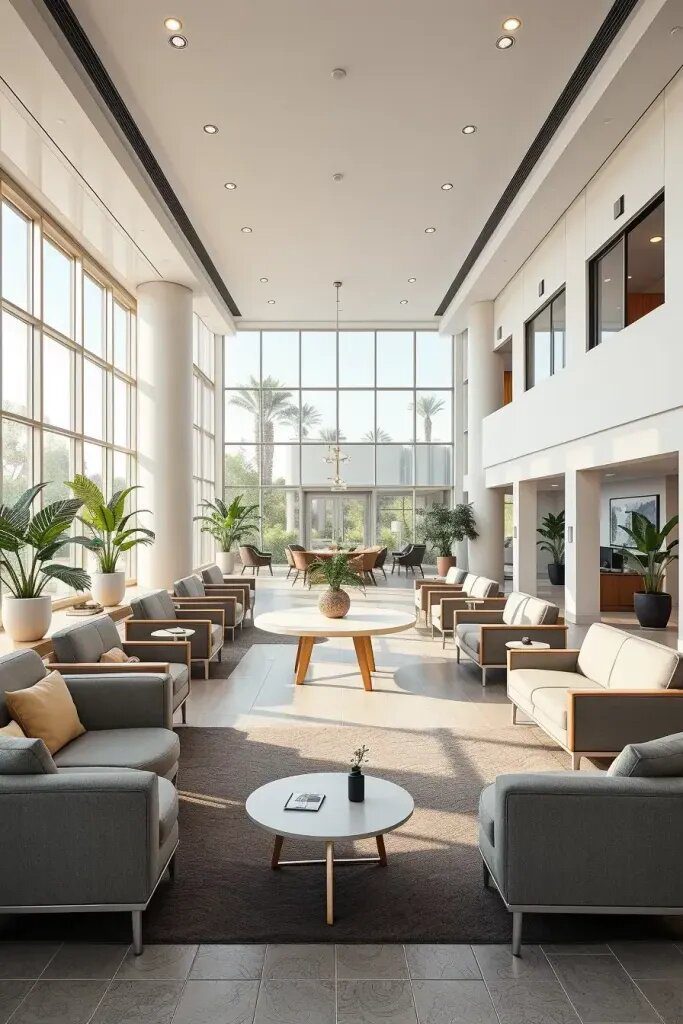
I usually like to keep my rooms open and spacious by using furniture that doesn’t block the flow. I like to have sectional seating or modular benches around the edges to keep things open and airy. I also use tables and rugs to define different areas in a soft and subtle way, without making the space feel cramped.

In my experience, I’ve found that open layouts not only make a room feel more spacious, but they also help save energy and bring in more natural light. According to Interior Design Magazine, having less cluttered spaces can reduce the need for artificial lighting and improve air circulation, which is good for the environment and adds to the overall look and feel of the room. So, open layouts have both practical and aesthetic benefits!
Whenever I look at blueprints, I always suggest getting rid of any built-in furniture and going with pieces that can be moved around easily. That way, you can switch things up as needed when the space evolves.
Modern Minimalist Furniture For Lobbies
When choosing furniture for a minimalist lobby, it’s important to keep things simple and focused. Each piece should serve a purpose and contribute to the overall look and feel of the space. I really pay attention to the style of the furniture, opting for sharp angles, shorter heights, and clean, solid shapes. Everything should have a function without being too big or flashy.

In my inventory, I’ve got some nice sofas in neutral colors, sleek benches with metal legs, and nested coffee tables with stone tops. They’re all modern and stylish, but also really practical. I’m not a fan of bold patterns or fancy trims – I like to keep things simple and classic.

In my opinion, it’s better to choose a few specific items that really make a statement rather than just picking random things. For example, I read in Dwell Magazine that timeless silhouettes are a great choice for spaces that you want to last and that are made with good quality.
You know, I’ve noticed that some lobbies can get pretty crowded with way too many seating choices. Personally, I like to keep things simple and only add more seats if we really need them. It’s all about letting the space decide what it needs, you know?
Letting nature in: Harnessing sunlight for design
Every minimalist lobby you come across has its own special vibe that comes from the natural light shining in. Not only does it brighten up the space, but it also brings out the natural textures and colors of the materials used. That’s why limiting excess and focusing on the essentials, like eye-catching windows, open views, and shiny surfaces, is key to creating a purposeful design. When it comes to crafting relaxing and stylish spaces, nothing beats the combination of light and sunlight.

When it comes to picking out furniture and decor, I recommend going for items with lighter matte finishes to help spread out the brightness in the room. Skylights and glass doors are also awesome at letting in more natural light and making the space feel even airier.

In my previous design work, I’ve found that lobbies with lots of natural light just have a certain vibe – they feel so roomy and inviting! Plus, it’s been shown that natural light helps boost mood, energy levels, and even decision-making. That’s why it’s super important for commercial entrances, according to Dezeen.
You definitely don’t want to make the mistake of blocking your windows with big furniture. In my experience, placing taller pieces or seating by the windows can really open up the room and let in lots of natural light without getting in the way.
Decorating Lobbies Using Texture Instead Of Color
When I design minimalist lobby interiors, I like to keep things simple and calming. Instead of bright colors, I focus on using neutral tones and textures like natural wood, stone, fabric, and matte metals. I find that these elements create a peaceful and sophisticated atmosphere without being overwhelming. It’s all about finding a balance and creating a sense of harmony in the space. I believe in modern minimalism and its emphasis on subtlety and elegance.
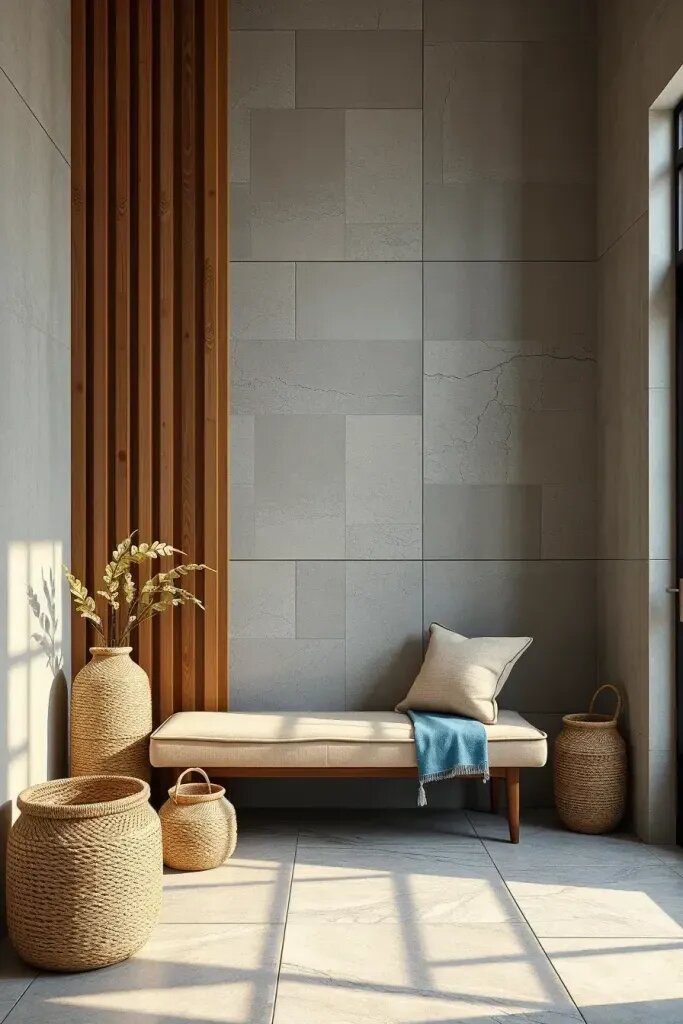
I love the idea of mixing cozy fabrics with smooth finishes. It’s like putting a textured oak panel behind a reception desk or adding a concrete accent wall next to a linen-covered seat – it creates dimension and warmth. I also like incorporating textured wall art, rugs, or storage baskets for a touch of quiet elegance.

You know, I always find it so interesting how surprised clients are when they see how cozy and welcoming a room can be without having to use super bright colors. Design Milk really hits the nail on the head by pointing out that texture gives a space that extra layer of depth and warmth that plain walls and furniture just can’t compete with.
In my opinion, people tend to overlook acoustical treatment when it comes to this kind of design. To make the space feel more cozy and reduce any echoing, I suggest incorporating some nice, thick fabrics.
How White Walls Can Transform Lobby Spaces
White walls are key in creating a minimalist lobby that really stands out. They provide a clean backdrop that highlights the shape and light of the space. Personally, I don’t just use white walls because everyone else does; I use them strategically to emphasize the architecture, materials, and specific decor elements. The result is a timeless entrance that feels open and modern.

So, I really love combining white walls with light wood furniture—it just gives such a fresh and airy vibe! And you know what? Neutral or black upholstered pieces also go really nicely with this look. Plus, when you have cool architectural features like arches or molding, the white walls just make them pop even more! Oh, and don’t forget about adding some subtle textures like limewash or microcement to the walls—they really help avoid that flat look and give the room some depth. It’s all about those little details that make a space feel cozy and inviting, don’t you think?

In my experience, I’ve noticed that people often see white as a boring color. But according to Domino Magazine, when white is layered and lit up just right, it can bring a calm and luxurious vibe to lobbies instead of feeling cold.
Hey, just a quick tip to consider when picking out paint colors for a room. Think about how much natural light you get in there – it can make a big difference, especially if you’re thinking about going with a bright white. If it’s not super well-lit, you might want to go with a softer off-white or cream instead. Just something to keep in mind!
Entry Hall With Minimalism Style Design
When it comes to designing the lobby, lighting plays a crucial role in creating a welcoming atmosphere. I believe that lighting shouldn’t just be functional, but should also be visually appealing. By using neutral colors in the décor, bold light fixtures can really make a statement and elevate the space. I love using pendant lights, sculptural pieces, or sleek LED fixtures to highlight the unique architectural details and create depth in the room.It’s all about finding the perfect balance between practicality and aesthetics!
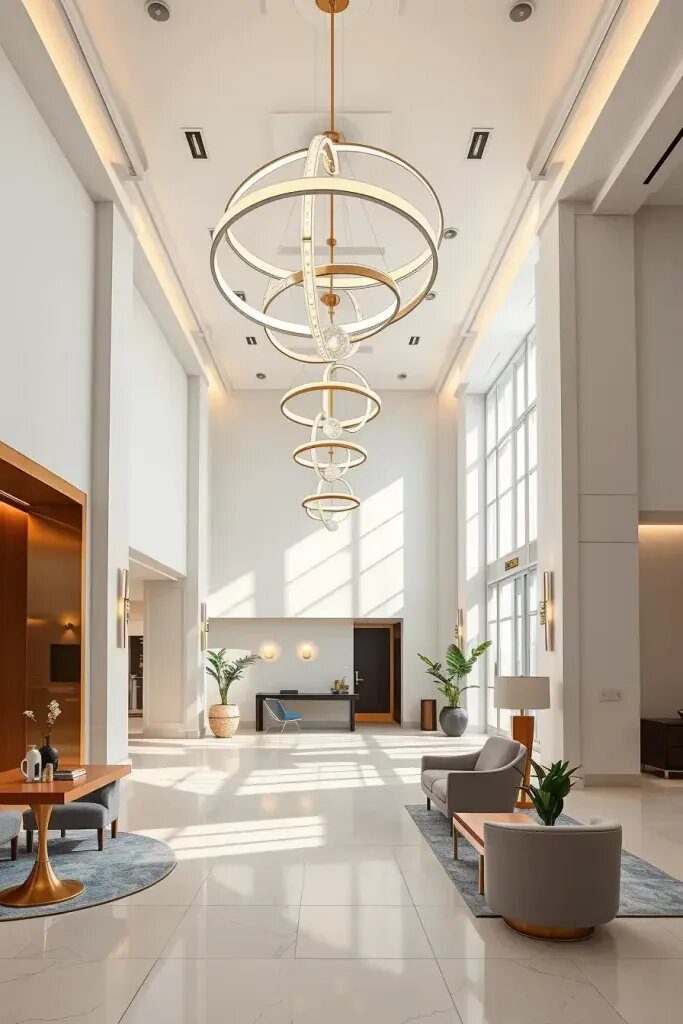
I really love light fixtures with matte textures like brushed brass and black powder-coated metal. Orb pendants and geometric chandeliers look awesome together, and I also like using thin LED strips in the ceiling to blend into the layout. These lighting choices not only serve a purpose but also help soften the overall vibe of the space. I always make sure to incorporate dimmable features into my lighting design for flexibility throughout the day.

I truly believe that good lighting can really make a room stand out and that’s especially true for minimalist spaces. Like Architectural Digest points out, the right lighting can enhance the rhythm and contrast in a room, as well as unify textures and colors. It’s amazing how just one well-placed light can completely transform a space, don’t you think?
Hey there, just a friendly tip – it’s usually a good idea not to go overboard. To keep things looking clean and stylish, I recommend sticking to just one standout light in each area. When you’re designing a modern minimalist lobby, using too many lights can throw off the overall vibe and aesthetic. Just something to keep in mind!
Adding a Cozy Touch With Beautiful Wood Details
I really believe that when designing a lobby, it’s important to mix in some warmth from nature. In my opinion, using wood elements can make a space feel inviting and cozy. Wood adds a comforting touch both visually and physically, without taking away from the overall design of the area. I think it’s all about finding that balance between cold materials and natural warmth.

I really love using trees like ash, oak, or maple in my designs because they bring a nice, soft touch and natural flair. I find that sticking to lighter or medium-toned woods helps keep things looking clean and fresh. Whether it’s adding vertical wood slats to a wall, floating shelves, or even a solid wood bench with visible grain, they all bring a sense of coziness to the space. Instead of heavy varnishes, I prefer to go with matte or oiled textures to give off a more relaxed and organic vibe in my designs. It just feels more natural and inviting to me, you know?

I’ve noticed that adding some wood to a room can really soften up that cold, sterile vibe and make it much cozier. Elle Decor actually talks about how incorporating wood tones into modern spaces can really spruce them up, making them more functional and interesting. This is especially important in places like commercial lobbies, where it’s easy for things to feel boring and unmemorable.
When I’m working on designs, I often notice that a project starts to feel more inviting and cozy once I start incorporating wood elements. I find that using wood repeatedly, whether it’s on the walls, furniture, or floors, really ties everything together and makes the space feel more harmonious.
Seating And Floating Benches Ideas
I really like using floating benches in compact or open minimalist lobbies. They’re not only functional but also help keep the space neat and tidy. Floating seating is literally attached to the wall, so it clears up the floor and creates a sleek look with clean lines. They work great in smaller spaces like mudrooms where you need to keep things streamlined and the flow of movement smooth.

When I work on my designs, I love incorporating materials like solid wood, leather, and sleek cushions with hidden fasteners. For instance, I might create a cool oak bench that appears to float with sleek black brackets, or a stunning marble slab that seems to hover without any visible support. I make sure the undersides of my designs are open, showcasing the floor and giving the room a more spacious feel. And to add some extra flair, I like to include integrated lighting in my benches for a cozy and inviting atmosphere.

I personally think floating benches are so cool and really add a touch of modern elegance. I read on Dezeen that they can be like a piece of art in your space and are a favorite among designers going for a sleek and unique look.
In my experience with these setups, I’ve noticed that some users might feel a bit unsupported without proper arm or side support. Personally, I like to use small block tables or stools nearby to not only improve the look but also make working easier and more comfortable.
Optimize Your Space with Custom Furniture Offering Storage Solutions
You know, I’ve noticed that minimalist designs, especially for lobbies, often don’t have much storage space. But surprisingly, they still manage to stay organized! It’s all about finding ways to maintain that sleek look while also keeping things tidy. That’s why incorporating built-in storage solutions is key. Things like wall-mounted storage panels, hidden cubbies, and integrated cabinets not only add a stylish touch to lobby design but also serve a practical purpose. It’s all about striking that balance between functionality and aesthetics.

Hey there! I love designing hidden built-in cabinets that seamlessly blend into walls without the need for handles. I use precise hinges and finishing touches to make them look like they’re part of the room. For example, I can create cabinets that go all the way down to the floor using a soft grey or sand laminate that practically disappears. Sometimes I’ll even add some wood for a cozy touch against the sleek surfaces. These cabinets are perfect for storing things like cleaning supplies, seasonal decorations, or extra guest essentials, all while keeping them out of sight.
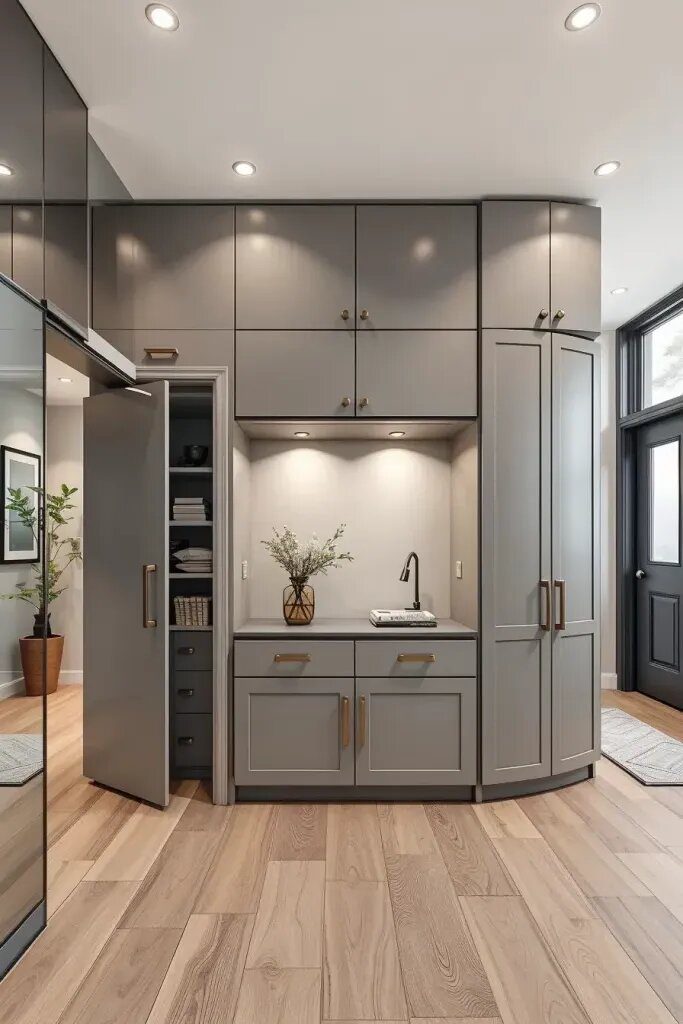
I really love hidden storage options because they can make a space feel so much neater and more organized. I read in Interior Design Magazine that having cleverly concealed storage is key to achieving a minimalist look, especially in busy areas like lobbies.
Hey there! One thing I think would be a great addition for commercial buildings is keyless access or smart lockers. I believe these features really help increase privacy and make the space more user-friendly. What do you think?
Minimalist Reception Desk Designed with Elegance
When you walk into a lobby, the reception desk is usually what catches your eye first, right? I like to think of it as a work of art that also needs to be practical – you know, it has to look good and be easy to use. I like to keep things simple and stylish, opting for strong, clean shapes with either sharp edges or gentle curves. I usually work with materials like wood, Corian, or polished concrete. I believe in keeping things clear and authoritative without going overboard.

When I create illuminated desks, I always think about practical features like storage and hiding cables. I like to give them a light and floating look by adding a sleek toe space. And I stick to neutral colors like white, wood, or light gray with a matte finish. I steer clear of flashy details like metal trims or glass tops because they can make the desk look old-fashioned.

I think a great reception desk should really enhance the overall look of the room. I read in Dwell Magazine that minimalism is becoming more popular in the design of fancy hotels and small businesses.
I think adding a low planter or a vertical sign panel would really enhance the overall look of the architecture and make it stand out even more. Just a few little details like that could really take the design to the next level while still keeping everything looking cohesive.
Powerful Minimalistic Lobby Art
I think having art in a minimalist lobby is all about finding the right balance, you know? For me, I prefer a striking wall sculpture or maybe just one standout canvas. I believe that art should always be a part of a space, but it should blend in nicely and not overpower it. What do you think?

I love abstract art! I’m drawn to soft, muted colors, simple photography, and neutral textures on big canvases. I like to keep things clean with floating frames or frameless mounts, and sometimes I’ll even do recessed installations. And if I want something really unique, I’ll make custom panels or collaborate with artists to blend architectural elements into the artwork.

In my opinion, having the perfect piece of art in the lobby can really set the tone for a building. Architectural Digest suggests using big art pieces to add some personality to sleek and modern interior designs. These kinds of artworks can really grab people’s attention, create a connection, and give the space a focal point without overwhelming it.
When you curate a collection with thought and care, it can really bring the art to life and tell a powerful story. Sometimes having one standout piece in just the right spot can make a bigger impact than having a bunch of artworks that don’t really connect with each other.
Adding a Touch of Nature: Incorporating Concrete and Stone for Added Texture
When I’m designing sleek, minimalist lobbies, I love using concrete and natural stone because they add such a unique touch with their textures and durability. They really help achieve that perfect balance of simple yet elegant vibes. And let me tell you, the rich textures in minimalist design are just everything – from smooth concrete floors to terrazzo walls and travertine reception desks. It’s all about creating that chic and inviting space!

I usually like to use materials like textured limestone tiles, poured concrete planters, and monolithic stone benches in big, seamless spaces. They add a touch of softness without being too fancy. I also prefer matte or semi-polished finishes to keep things looking natural and avoid any harsh glare.
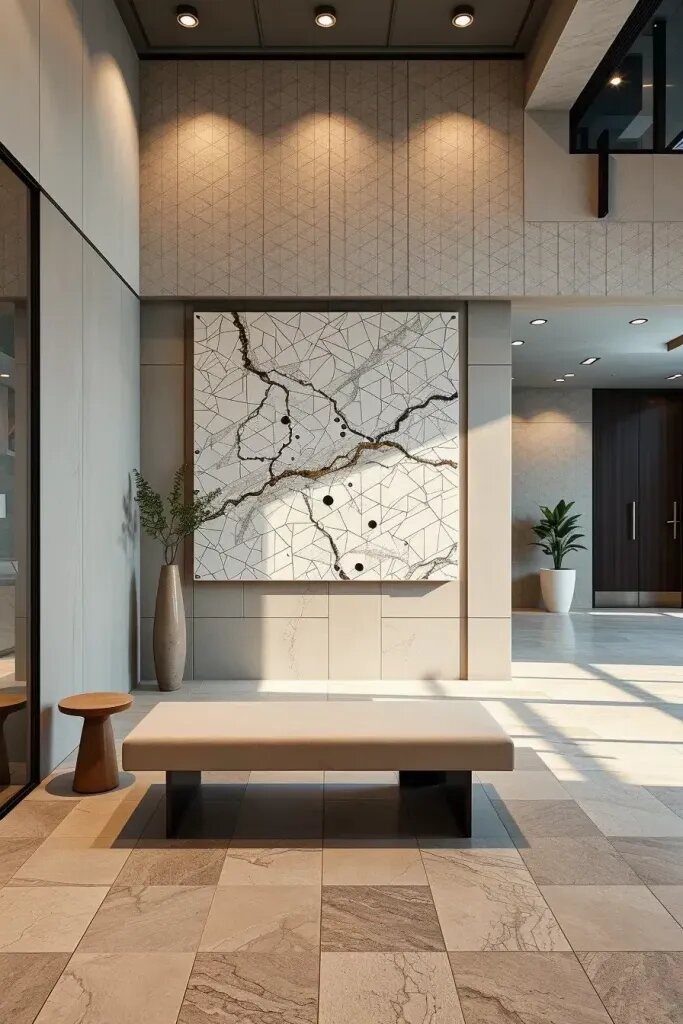
I personally love using stone and concrete in interior design because they bring a real sense of nature into a space. Design Milk says that these materials add a luxurious yet rugged beauty that perfectly matches the current tastes of customers.
If you have a lobby that gets a lot of foot traffic, I recommend sealing the natural stone floors to make them more durable. A matte sealant can help protect the stone and keep it looking beautiful without taking away from its natural charm.
Sleek Finish: Enhance Your Space with Frameless Glass Doors
I really love how frameless glass doors add a touch of elegance and functionality to modern minimalist lobbies. They help keep the space open and uncluttered, while also being super practical for coming and going. Plus, they let natural light flood in, making even the smallest lobbies feel welcoming and roomy. I think their see-through design fits perfectly with the clean and simple vibe of minimalist decor.

I usually suggest using tempered or laminated glass with hidden hinges or floor pivots because they make the doors easy to open and close. Instead of big bulky frames, I like the clean and modern look of a simple design. Adding matte black or brushed aluminum handles gives a nice touch of contrast. In busier spots, automatic sliding glass doors are a great choice. They keep things looking sleek and tidy while making it super easy for people to come in and out.

It always amazes me how clients react when they see how much of a difference frameless doors can make in a space. They create this cool floating effect that really highlights the materials and layout of the lobby. Just like iElle Decor pointed out in their article on minimalist design, frameless entry systems add a touch of “quiet luxury” and help with the flow of space, which is so important in design trends today.
If I could suggest one thing to make it even better, I would say let’s add some soft-close hardware or door dampers. They really make a difference and enhance the whole experience without taking away from the sleek and modern look we’re going for.
Green up your space with stylish planters and minimalistic greenery
I believe that every minimalist lobby needs a touch of greenery to truly feel complete. I like to use plants in sleek, minimalist planters to soften up all those clean lines and neutral colors. They just bring a sense of life to the space and help balance out the coldness of materials like stone and glass. It’s all about adding that emotional touch without making the space feel too crowded, don’t you think?

I suggest going for planters made of concrete, matte ceramic, or powder-coated aluminum for a sleek look. Stick to basic shapes like circles or squares and choose plants with a more defined structure like snake plants, rubber figs, or fiddle leaf figs. Adding some tall indoor palms or a bonsai tree in the middle can really bring some style to a plain room.

Personally, I just love adding some greenery to a room. It really adds a grounding element that offsets the airy feeling that minimalism can sometimes give off. Architectural Digest calls foliage “the most honest design accessory,” and I totally see why. It brings so much life and feeling to a space without making it feel cluttered.

You know, if I had to suggest something, I think it would be a good idea to include integrated irrigation systems or self-watering planters for Commercial Lobbies. It just makes things easier to maintain and more efficient in the long run.
Using Different Lights to Add Depth and Ambiance
I think lobbies should keep things simple with a minimalist style, don’t you? And lighting should be more than just about making things bright. I like to divide lighting into three zones: ambient, accent, and decorative. Each zone has its own unique vibe that helps create the right visual atmosphere. Lighting can really bring out the depth of a space without making it feel crowded or overwhelming.

Some recessed ceiling lights are enhanced by step lights to give a nice, soft glow in the room. You can also use sconces and stylish floor lamps to give your space an extra touch of flair, along with hanging pendants and chandeliers to create a cozy atmosphere.

All of these elements will help us reach our goals; I love how lighting can create a minimalistic vibe that I enjoy. It’s amazing how a white room can feel warm or cool, big or snug, just by adjusting the temperature and intensity of the light. I read in Dwell magazine about layered lighting being the new must-have in architecture, and it’s exactly what I imagine for turning simple layouts into captivating spaces where every corner tells a story.
To make this feature even better, you can add in some smart lighting technology that adjusts the brightness and color based on the time of day. It really helps set the mood in the lobby without much work on your end!
Subtle Differences in Black and White Hotel Entrances
One lobby design that I absolutely love is the minimalist monochromatic style with different textures and contrasts. I’ve tried this out in some spaces to make them feel peaceful and elegant without being boring. The key is to use different shades of white, gray, taupe, or black to add depth and keep things looking clean and simple. It really does make a difference!

I love personalizing spaces with sleek surfaces like stone tile, concrete panels, or light oak. Mixing it up with comfy benches and stools in cozy fabrics like boucle, linen, and felt adds a nice touch. And don’t forget about those little details like black accents on table legs and door handles that really tie the space together. It’s all about creating a welcoming and stylish atmosphere!

I’ve noticed that when monochrome is done right, it really captures the essence of minimalist poetry. People seem to love it too – they tend to stay longer, taking in all the textures and light. According to a recent article on Dezeen, the latest trend in hospitality design is all about quiet contrast over color maximalism.
Hey, I was thinking it could be really cool to add a sculptural piece or a cool piece of artwork with colors that all kind of go together. Having freestanding pieces like that can really make a statement and tie everything together in the room. What do you think?
Streamlined Functionality and Aesthetic Design
When I’m working on creating a minimalist lobby, one key thing I focus on is keeping the space clutter-free while still making sure it’s functional. I typically start by thinking about how people will move through the space and plan accordingly. Being minimalist doesn’t mean having less furniture, but rather carefully thinking about how each piece serves a specific purpose in the room.

I really like furniture that has hidden storage, like benches or console tables with drawers. It just makes things so much easier to keep organized. I also prefer built-in reception desks and wall-mounted shelves because they help keep things clean and tidy. I feel like smaller decorative items can be too much sometimes, so I usually go for bigger, more balanced pieces to keep things looking spacious and less crowded.

I often hear from clients how much calmer and concentrated they feel in a tidy lobby. It’s interesting because Psychology Today actually found a connection between simple designs and reduced stress levels. I’ve seen firsthand how offices with clear divider walls and a clean, simple lobby layout tend to boost productivity.
If I had to make a tweak, I’d go for some versatile modular seating. It’s a simple touch that can cater to individuals or small groups without taking up too much space.
Sculptural Progressions As A Point Of Focus For Minimalism
In simple lobbies, it’s important to choose decor that speaks to you and offers a personal touch. I believe that adding sculptural pieces can really bring a space to life and make it feel more inviting. I like to pick pieces that have a certain elegance and can draw your attention while still complementing the overall design of the room. Sometimes it’s easy to overlook these subtle touches, but once you notice them, they add so much charm. I especially love pieces that have a natural or abstract feel, like something carved from stone or metal. It’s these little details that can make a big difference in a minimalist space.

I love using blackened steel pedestal sculptures, white marble pedestals, and other unique pieces like that in my designs. They really make a statement without overwhelming the space. Sometimes I also like to incorporate art walls or suspended art to add some movement and depth without adding too much extra decor. It’s all about creating a balanced and interesting atmosphere!

In my opinion, having a big, eye-catching sculpture can really spruce up a lobby while keeping that sleek minimalistic style. I was reading an article in Interior Design Magazine that talked about how sculptural lighting is becoming more and more popular because it serves as both a light source and a piece of art.
I think it’d be amazing to have local artists work with us on some collaborations. Imagine custom art pieces that really capture the essence of our building and complement our minimalist style. It could really add a special touch and make a lasting impression on our visitors.
Choosing the Best Flooring for Your Minimalist Lobby
When I’m designing floors for minimalist lobbies, I like to focus on creating a harmonious and beautiful space. I aim for a look that’s elegant, subtle, and practical all at the same time. I usually recommend using materials like polished concrete, large porcelain tiles, or wide matte oak planks. These choices not only look great but also help to bring a sense of soft light and a seamless flow to the area.

I like to stick to neutral colors like light gray, warm beige, and charcoal because they blend in well with the overall color scheme. I also prefer seamless finishes, floor heating, and no rugs to keep things looking smooth and uninterrupted. And can I just say, epoxy resin is such a great choice for corporate buildings – it’s super durable and gives off a sleek vibe that’s hard to resist!

I really think that the surface of a room plays a huge role in how much it’s worth. One of the installations I absolutely love is the soft stone terrazzo with micro aggregate. It adds extra texture without taking away from the simple vibe of the space. As Architectural Record pointed out last quarter, “the flooring can tell a story in minimal design.”
If you’re looking to make things even better, consider putting in some sound-absorbing underlays. They really help make those big, empty spaces feel cozier. It’s all in the little things!
Incorporating Discreet Innovative Technology
In a modern minimalist reception area, it’s important for the lobby to be both practical and beautiful. I focus on blending smart technology like security systems, fancy lighting, and climate controls in a way that’s subtle and seamless. The key to the design’s sophistication lies in its simplicity. The goal is for the technology to enhance the space without overshadowing it.

When I work on my projects nowadays, I always make sure to add cool features like motion light sensors, hands-free access control systems, and hidden speakers. I also love installing wall tablets that blend right in with the walls. And I make a point to hide all the wiring and add charging ports in the walls to keep everything looking neat and tidy. One of my favorite things to use is smart glass that can tint on its own based on the light or privacy needs of the space. It’s all about creating a futuristic and innovative vibe for my projects!

I always think it’s super important to have smart technology in your projects these days. People just expect it! But if you do decide to use it, make sure it fits well and looks good. There’s this quote I love from Wired Design that says, “tech should blend in until you need it,” and I find it really helpful when incorporating smart features into clean and simple designs.
We should focus on making smart devices easy to use and hands-on. Let’s avoid using overly complicated technology that just makes simple tasks more difficult. Keep the reception area simple and clutter-free for a clean and clear look.
Curved Lines In Modern Minimalist Lobbies
When it comes to my work as an architect, I like to think outside the box and incorporate curves into my designs. It goes against the typical minimalist look of straight lines and symmetry, but I find that it adds character and softens the overall feel. Plus, when you have curves in the design, it just feels more natural for people to move around in the space. It helps break up any monotony and creates a welcoming flow throughout the building.

I love how rounded walls, arched doorways, and curved reception desks give off such a classy vibe. And don’t even get me started on those rounded or oval coffee tables in the waiting rooms – they just tie everything together so nicely! It’s like they’re saying, “Come on in, we’ve been expecting you.” Oh, and let’s not forget about the indirect lighting that follows the curves of the space – it really enhances the whole design, don’t you think?
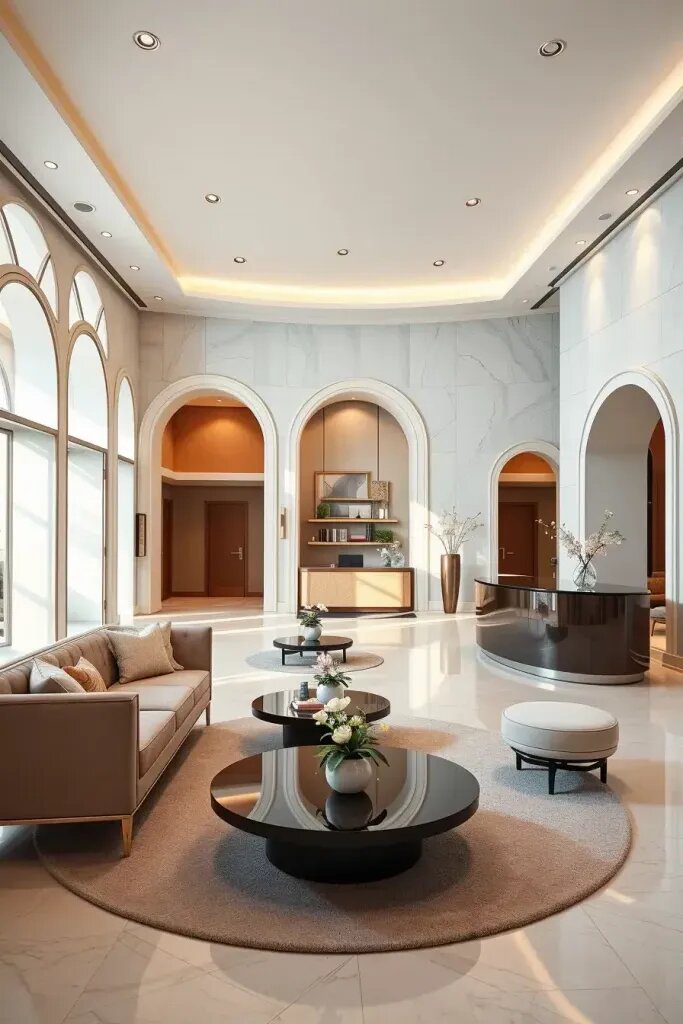
You know, I’ve noticed something interesting lately. It’s that people seem to really enjoy minimalist lobbies that have a more relaxed and inviting vibe. I mean, who wouldn’t want to hang out in a space like that, right? It’s like a breath of fresh air. And apparently, interior analysts are calling it “soft minimalism”, and it’s becoming pretty popular. My clients in the hospitality industry are loving it too.

Just a friendly heads up – don’t go overboard with the curves. If you add too many, it might lose its original purpose. Keeping a minimalist design requires some visual balance and self-control.
Transforming Entryways with the Magic of Mirrors
When it comes to design, mirrors are like magic wands that can instantly brighten up a room, create the illusion of more space, and bring life to boring entryways. I love using mirrors to liven up dark corners and showcase the beauty of a room’s architecture. Plus, they’re a great addition to any minimalist or classy decor – they’re practical and add a touch of elegance without going overboard on the decorations.

I really like the look of frameless wall-mounted mirrors, vertical mirror strips, and framed mirrors on walls. It’s all about finding the right spot for them – I usually place them opposite windows to make the most of natural light, or behind benches to make the room feel bigger. And if I’m going for a more vintage vibe, I love mirrors with antiqued finishes. Just adds a little extra charm, you know?

I’ve seen some amazing transformations with mirrors, especially in apartment lobbies and boutique hotels. It’s kind of like when a client once told me that having mirrors in their entrance made it feel much bigger. I’ve noticed mirrors are a popular design trend and I even read in a 2024 issue of Elle Decor that they’re considered “the minimalist’s secret weapon,” and I totally agree with that!
When choosing mirrors for public spaces, it’s important to go with ones that have safety glass edges and are securely anchored. You want to make sure they not only look good but also keep everyone safe.
A Guide To Sophisticated And Minimalist Apartment Lobbies
When designing lobbies, it’s important to make them feel warm and welcoming. We want guests to feel cozy and at home as soon as they walk in. Instead of going for a super sleek and minimalist look, we should aim for a more comfortable and welcoming vibe. Soft lighting in seating areas and a mix of materials are key to achieving this inviting atmosphere, especially compared to the more formal and rigid look of the corporate world.

Typically, we stick with more neutral colors for the color scheme – think cream, taupe, and light gray. When you add in some comfy cushioned benches, pendant lamps, and walls covered in wood veneer, the whole place just feels cozier, you know? And we always think about the person using the space – that’s why we’ve got sleek wall-mounted mailboxes, cute little sculptural decor on console tables, and sometimes even some soft rugs to really make it homely.

You know what I love most about apartment lobbies? How they can feel both personal and classy at the same time. One design I came up with featured a walnut paneled wall, a mirror inset, and a floating console, giving it a sleek and modern look while still allowing residents to add their own touch. I really like how Dwell magazine emphasizes creating a cozy, homey vibe in shared spaces, and I always keep that in mind when making design choices.
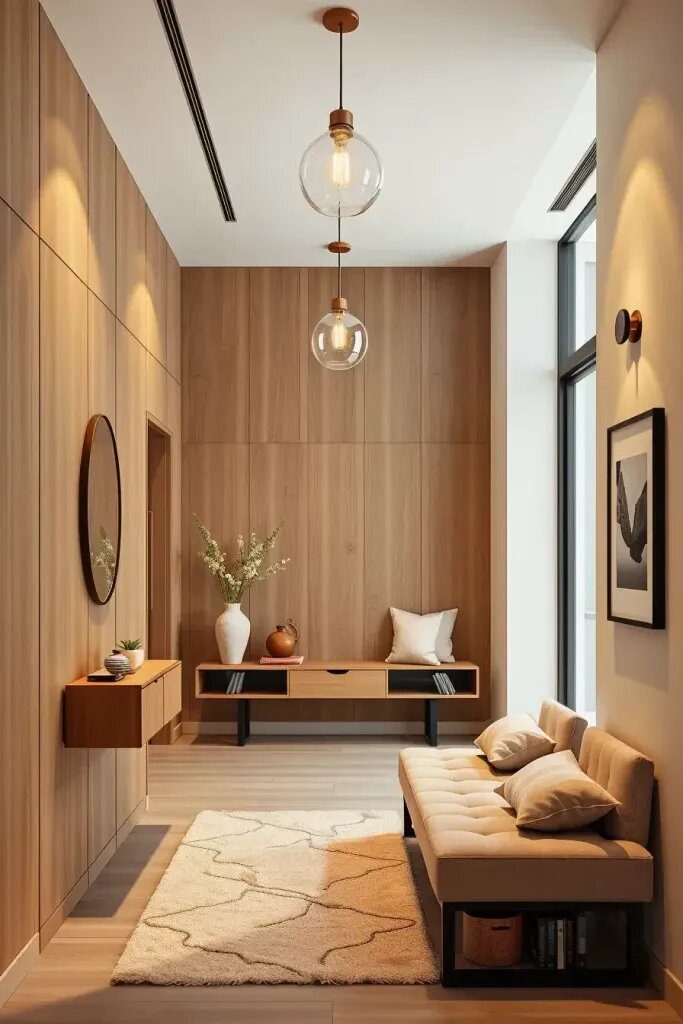
You know, one thing I think could make a big difference is having more signs that help guide people. Sometimes it can be kind of confusing trying to find your way around. I think adding some clear, simple directional signs would really help. I like the idea of using etched glass or metal letters because they look classy and don’t mess with the overall look of a place.
Designing Cozy Small Lobbies with Minimalist Touches
When it comes to smaller lobbies, minimalism can really work wonders! It just takes a careful touch. Personally, I always like to begin by looking at proportions and adding in vertical elements like sleek, space-saving furniture to draw the eye upwards. The key is creating a sense of openness, rather than just having everything look bare.

Some of the things I really love in a space are storage solutions that make life easier, mirrors to brighten things up, and comfy wall-mounted benches. And you know what really makes a difference? Those little touches like a slim console table, a cool sculpture, or some stylish wall sconces. I find that keeping a simple color scheme and using just a couple of materials per room, like polished concrete or matte brass, helps keep things looking sleek and uncluttered.

Based on what clients have been telling us, it seems like people love when things are clear and simple, and they really enjoy the sense of openness that minimalism creates. When a space is small, every design choice is important and has a specific purpose. As the editors of Interior Design Magazine say, “Being minimalist is all about knowing when to hold back – especially in smaller spaces, it’s key to keep things simple.”
I think it would be a great idea to use invisible doorframes or integrated HVAC grilles to support that concept. These architectural features can really help maintain a nice flow and make everything look more cohesive.
Simplifying the Look of Corporate Lobbies
We understand the importance of the reception area in representing a company’s brand. It’s all about conveying trust, innovation, and sophistication through the design. Nowadays, many companies are opting for a more minimalist approach. When it comes to design, it’s always important to think about the overall strategy. Every aspect, from the materials used to the layout and lighting, should be in line with the company’s identity.

When you walk into the check-in areas, you’ll notice some cool design elements like big tiles, glass dividers, sleek reception desks, and modern light fixtures. Personally, I really like the sliding glass doors that have the brand logos etched on them, or the walls painted in the brand colors. The mix of neutral tones keeps everything looking classy without being too overpowering in the space. It’s those little details that make the place stand out!

In my opinion, the best corporate lobbies are the ones that are calm and peaceful. They give people a chance to relax, breathe, and appreciate the surroundings. I really believe that the key to successful branding is creating a welcoming environment, and simple reception areas are a great way to showcase that idea without a lot of fuss.
You know what a lot of people overlook when it comes to design? Acoustics! It’s so important, especially in busy reception areas where there’s tons of foot traffic. Throw in some acoustic paneling or some cozy area rugs and you’ll see a real difference in how people feel in that space. It’s all about making it super welcoming without going overboard on stuff.
Embracing Zen: Incorporating Serene Elements into Lobby Design
Imagine walking into a calming Zen-inspired lobby that focuses on simplicity, nature, and peace. When designing these spaces, we strive to find the perfect balance between openness and structure, blending soft elements with harder ones, and combining materials with empty spaces. This type of design is perfect for high-end apartments, luxurious spas, or wellness centers.

I love to bring in elements of nature like natural stone, wood slats, shoji screens, and cool features like gravel gardens and water elements. I like to keep the furnishings simple and cozy, with things like natural oak benches and floor cushions on soft, textured rugs. And when it comes to lighting, I always aim for that warm, soft glow you see at sunrise or sunset.

I personally believe that designing Zen spaces is one of the most rewarding paths in the design field. The goal is to make the guests feel grounded and at peace. I always think of a lovely quote I once read in Kinfolk that said, “A space that breathes allows people to breathe.” That’s the essence I aim for when creating tranquil spaces.
To make the experience even better, I would suggest adding scent diffusers and soothing nature sounds to help relax your mind even more. It really adds to the whole Zen vibe and makes everything feel even more peaceful and calming.
Crafting a Warm Atmosphere Through Subtle Aromas
In my opinion, a truly memorable lobby design is more than just about looks – it should also appeal to our other senses. One aspect that doesn’t always get enough attention but can make a big impact is the subtle use of scent. The right fragrance can set the mood even before guests walk in and take in the beauty of the lobby. For spaces that favor a clean and simple aesthetic, scent can be like a soft, soothing voice. I recommend using essential oil diffusers or HVAC scent systems to gently fill the air with scents like sandalwood, white tea, and citrus.

When picking out furniture, go for pieces that won’t steal the show visually. I love the look of an upholstered bench in walnut or ash wood paired with a sleek walnut console table. Keep it simple with glass vases or natural stone vessels to hold reeds or diffusers, they fit right in with a minimalist style. I like to mix in matte finishes and natural textures to create a balanced and harmonious vibe, while the subtle scent adds a little something extra to the atmosphere.

From what I’ve seen, having a nice scent in the air can really make your guests feel welcome as soon as they walk in the door. As Architectural Digest puts it, “Scent is the secret weapon of hospitality.” I remember on one project I worked on, I chose a bergamot scent for the corporate lobby and it totally transformed the space into a refreshing and classy environment, without needing any extra decorations.
I think it would be really cool if minimalist spaces started incorporating scents into their design. Imagine changing up the fragrances each season to match the vibe of the space. It could really add a unique touch and help create a signature atmosphere for the brand.
Let’s Play with Colors: Mixing Neutrals
When it comes to keeping lobbies simple and stylish, playing around with different shades of neutral colors can really make a space stand out without overwhelming it. Personally, I like to mix and match tones like white, beige, soft grey, and taupe to subtly define different areas and guide people as they move through the lobby. It’s a great way to add some visual interest and flow to a space that might otherwise feel a bit plain. This trick works especially well in lobbies that need to feel welcoming and organized at the same time.

I love using floor finishes like big gray slate or light terrazzo to set the stage in a room. The walls can have a mix of warm white and deep greige, creating a peaceful atmosphere with pockets of light. As for furniture, I lean towards sleek tables in stone or metal, along with cozy taupe linen sofas and cream boucle chairs. I aim for a palette of muted tones and gentle hues to bring everything together.
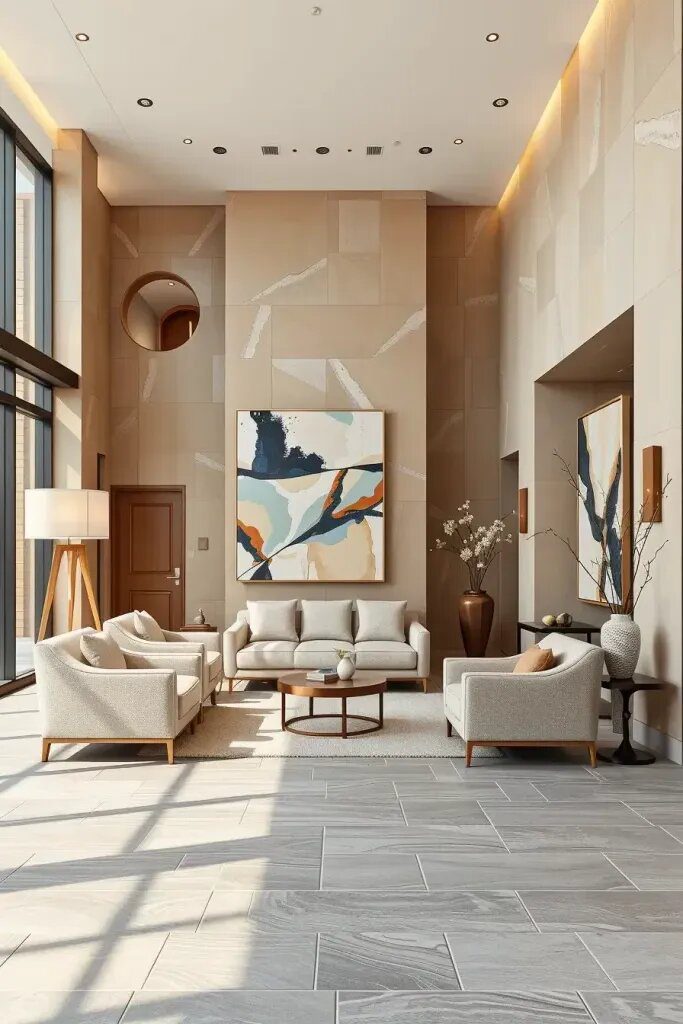
So, this technique we’ve been using has really been a hit in making homes and fancy hotels look amazing. It’s especially great for designing lobbies in high-end apartments where folks want that chill, cozy hotel feel. By keeping things simple and using neutral colors, we’re able to create a space that feels just right without being too busy. Plus, it gives off a sophisticated vibe that people love, as pointed out by Elle Decor.
You know, sometimes those minimalist lobbies can feel a bit empty when it comes to art, especially the color blocked ones. But if you want to add a little something without overpowering the space, consider putting in a big abstract canvas or a simple matte sculpture in neutral tones. It can really tie the room together and give it a little more depth, you know?
Revamping Lobby Spaces with Modern Flair
When it comes to designing a hotel lobby, I always aim for a perfect blend of beauty, practicality, and resilience. I like to create a space that feels inviting and comfortable, with a good balance between all the elements. That means using open sightlines, natural materials, and a limited color scheme to keep things feeling cohesive.
In the reception area, I like to keep things simple yet stylish. A sleek stone or wooden desk with soft LED lighting can make a big impact without overwhelming the space. And when it comes to the flooring, I opt for large tiles made of porcelain or natural stone to create a seamless look that adds to the overall feeling of openness. It’s all about enhancing the visual flow and making guests feel at ease as soon as they walk in.

I love putting together a cozy and stylish living space with modular sofas, eye-catching chairs, and elegant coffee tables. These pieces not only add character to a room but also serve as essential furniture. I always like to incorporate some greenery with built-in planters featuring olive trees or dracaena to bring a touch of nature indoors. It really helps to soften the space and create a lasting, minimalist look. And when it comes to lighting, I like to mix things up with recessed LEDs for a cozy atmosphere, sculptural pendants for some drama, and task lighting that’s cleverly integrated into the architectural elements. It all comes together beautifully to create a warm and inviting atmosphere.

So, I was reading in Hospitality Design Magazine recently about how simplifying the layout at check-in has really made a positive impact on guests’ experience. In my own experience working in boutique hotels, I’ve noticed that guests really appreciate clean lines and a clutter-free space. It just makes everything feel more elegant and flows better, you know?
I think it would be cool to consider adding some subtle touches to help with getting around, like using different textures, lighting, or ceiling finishes. It could make moving through the space feel more intuitive and easy. Plus, it would keep everything looking neat and organized while still feeling welcoming and functional.
Integrating Art In Minimalist Lobby Design
Many folks think that minimalist lobbies don’t have any art, but that couldn’t be further from the truth. Personally, I believe that art is crucial for defining the character of a minimalist space. The tricky part is figuring out how to blend it seamlessly into the design. Whether it’s a striking sculpture or a large abstract painting, it can really bring the room together. I like to stick to monochromatic or earthy tones for the artwork to keep it in line with the minimalist vibe, even though it still manages to make a statement.

When it comes to furnishing a room, I like to set things up like they’re in a gallery – you know, with plenty of space around each piece. Sometimes all you need is a nice oak bench, a cool floor lamp, and a couple of comfy armchairs. I always make sure to mix different materials like stone, wood, metal, and textured fabrics to add some depth without taking attention away from the art. Oh, and gotta have those walls in a matte finish and the lighting angled just right so everything looks nice and cozy.

In my opinion, having just one really eye-catching piece can totally transform a lobby. I read on Dezeen that with minimalism, every choice you make is important, even what you choose not to include. For example, I once had a big, striking black-and-white painting made for a hotel in New York, and it blended in perfectly with the simple decor without taking over the space.
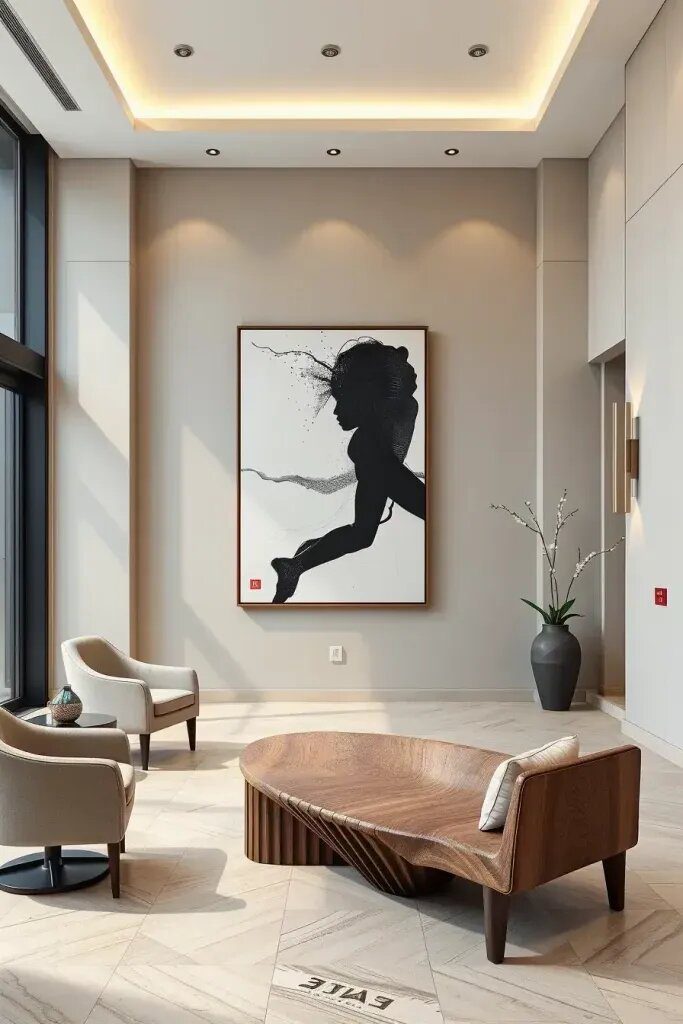
Instead of just using art for decoration, designers should really think of it as a big focal point in minimalist lobbies. It’s all about having a couple of really impressive, top-notch pieces instead of lots of smaller ones to keep everything looking clean and cohesive.
Have you ever noticed how Modernist lobbies are about more than just simple shapes? They use clean lines to communicate a wealth of information, engaging all of our senses with their thoughtful design. The combination of functionality and simplicity brings a new level of beauty to hotels and offices.
Have you ever tried implementing any of these ideas yourself? We’d love to hear about your experiences in the comments below. Your feedback is always welcome!



